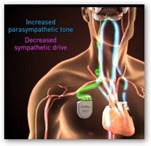This is yet another interesting device as the article states many other solutions are burning nerves but this one takes the pacemaker approach to keeping blood pressure down. It is being studied in the US for those patients who are not having a good response with drugs. T he device already has European approval and is currently sold and used as an alternative method to control high blood pressure. It reports to a web based application so here we go with the “data selling” question again. If and when approved in the US, there’s that excise tax to pay and the company is not quite profitable yet. Read the link below on what may happen to your data and there’s a great solution to nullifying the device tax. The video below goes into detail on how this works.
he device already has European approval and is currently sold and used as an alternative method to control high blood pressure. It reports to a web based application so here we go with the “data selling” question again. If and when approved in the US, there’s that excise tax to pay and the company is not quite profitable yet. Read the link below on what may happen to your data and there’s a great solution to nullifying the device tax. The video below goes into detail on how this works.
It appears to also have some of the same benefits as a pacemaker so perhaps we get to two for one here with helping with other heart problems? This is interesting some patients take several medications to treat their blood pressure. BD
One More Reason To Repeal the Medical Device Tax – Device Companies May Sell Your Data to Pay Their Taxes – Money Has to Come From Somewhere And They Create Jobs in the US
Implanted Medical Device to Control Blood Pressure
While dozens of medical device makers are racing to treat
 medication-resistant hypertension by burning nerves inside arteries in the kidneys, Minneapolis firm CVRx is coming at the problem from a different direction.
medication-resistant hypertension by burning nerves inside arteries in the kidneys, Minneapolis firm CVRx is coming at the problem from a different direction. Its implantable pacemaker-type device stimulates pressure sensors in the carotid arteries -- essentially fooling the brain into lowering blood pressure. The system is minimally invasive, adjustable and reversible -- and the results from it are dramatic, said CVRx President and CEO Nadim Yared
A small device, like a pacemaker, is implanted under the collar bone. A thin wire runs from the device along the carotid artery with an electrode about the size of the head of a nail. Doctors then use an external system to program and customize therapy settings.
Implanting the device usually takes an hour or two and can be done on an outpatient basis, although some patients stay overnight at the hospital.
Yared said patients in the Barostim neo studies have averaged a systolic pressure of 183; the device lowered the pressure of about half those patients to below 140.
Dr. Eric Irwin, a vascular surgeon at North Memorial Medical Center in Robbinsdale, has been involved with the CVRx technology for several years and holds stock options in the company.
Barostim neo already is being sold for treating hypertension in Europe. CVRx is expected to earn about $2 million in 2012, Yared said. It continues to be studied for treating medication-resistant hypertension in the United States, as well as for treating heart failure in the United States, Canada and Europe. Yared said he expects the company to become profitable before FDA approval.
http://www.startribune.com/business/181633521.html



0 comments :
Post a Comment